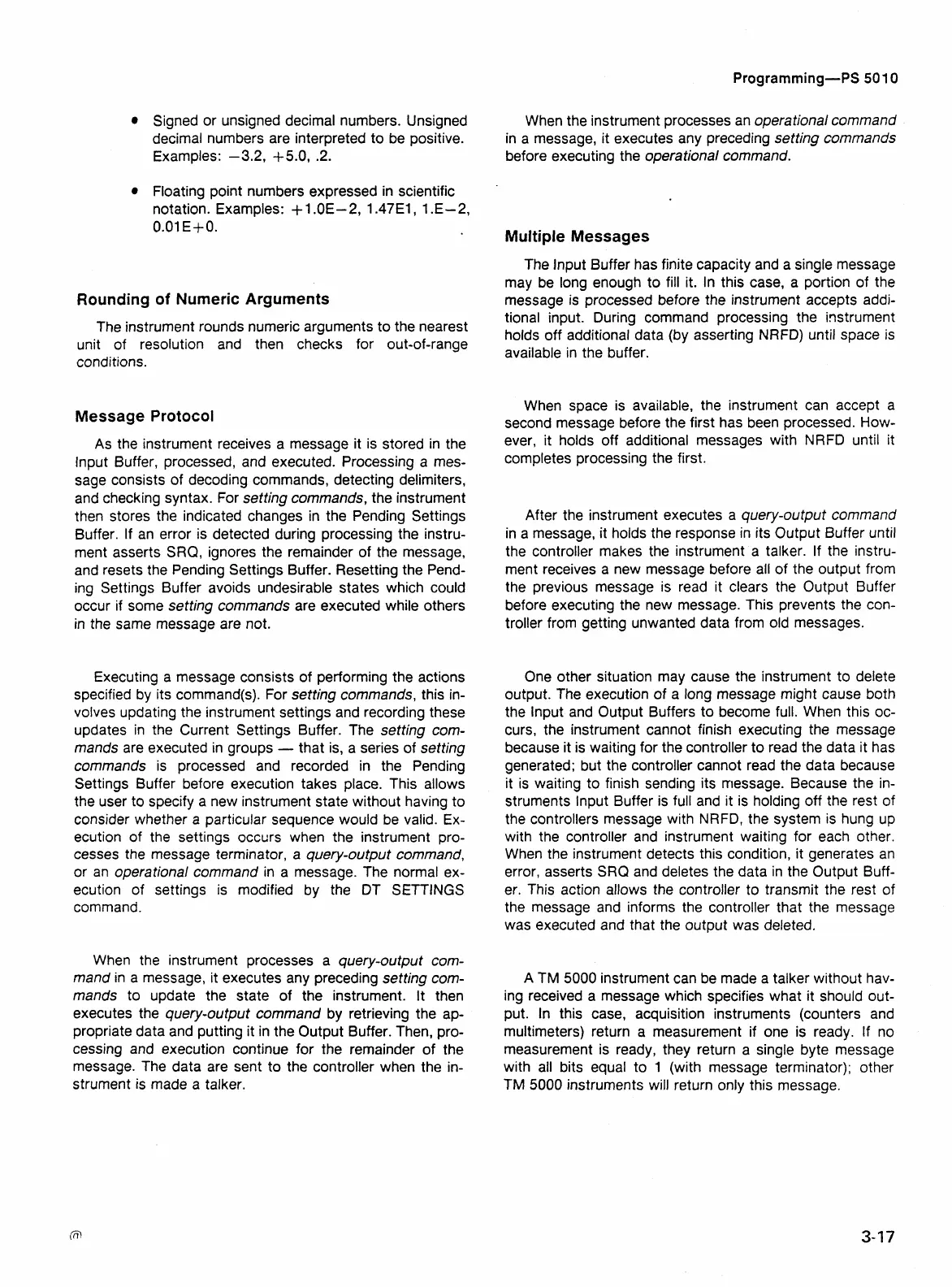Signed or unsigned decimal numbers. Unsigned
decimal numbers are interpreted to be positive.
Examples: -3.2, +5.0, .2.
Floating point numbers expressed in scientific
notation. Examples:
+
1
.OE-2, 1.47E1,
1
.E-2,
0.01 E+O.
Rounding of Numeric Arguments
The instrument rounds numeric arguments to the nearest
unit of resolution and then checks for out-of-range
conditions.
Message Protocol
As the instrument receives a message it is stored in the
lnpu t Buffer, processed, and executed. Processing a mes-
sage consists of decoding commands, detecting delimiters,
and checking syntax. For setting commands, the instrument
then stores the indicated changes in the Pending Settings
Buffer. If an error is detected during processing the instru-
ment asserts SRQ, ignores the remainder of the message,
and resets the Pending Settings Buffer. Resetting the Pend-
ing Settings Buffer avoids undesirable states which could
occur if some setting commands are executed while others
in the same message are not.
Executing a message consists of performing the actions
specified by its
command(s). For setting commands, this in-
volves updating the instrument settings and recording these
updates in the Current Settings Buffer. The setting com-
mands are executed in groups
-
that is, a series of setting
commands is processed and recorded in the Pending
Settings Buffer before execution takes place. This allows
the user to specify a new instrument state without having to
consider whether a particular sequence would be valid. Ex-
ecution of the settings occurs when the instrument pro-
cesses the message terminator, a query-output command,
or an operational command in a message. The normal ex-
ecution of settings is modified by the DT SETTINGS
command.
When the instrument processes a query-output com-
mand in a message, it executes any preceding setting com-
mands to update the state of the instrument. It then
executes the query-output command
by
retrieving the ap-
propriate data and putting it in the Output Buffer. Then, pro-
cessing and execution continue for the remainder of the
message. The data are sent to the controller when the in-
strument is made a talker.
When the instrument processes an operational command
in a message, it executes any preceding setting commands
before executing the operational command.
Multiple Messages
The lnput Buffer has finite capacity and a single message
may be long enough to fill it. In this case, a portion of the
message is processed before the instrument accepts addi-
tional input. During command processing the instrument
holds off additional data (by asserting NRFD) until space is
available in the buffer.
When space is available, the instrument can accept a
second message before the first has been processed. How-
ever, it holds off additional messages with NRFD until it
completes processing the first.
After the instrument executes a query-output command
in
a
message, it holds the response in its Output Buffer until
the controller makes the instrument a talker. If the instru-
ment receives a new message before
all of the output from
the previous message is read it clears the Output Buffer
before executing the new message. This prevents the con-
troller from getting unwanted data from old messages.
One other situation may cause the instrument to delete
output. The execution of a long message might cause both
the lnput and Output Buffers to become full. When this oc-
curs, the instrument cannot finish executing the message
because it is waiting for the controller to read the data it has
generated; but the controller cannot read the data because
it is waiting to finish sending its message. Because the in-
struments lnput Buffer is full and it is holding off the rest of
the controllers message with NRFD, the system is hung up
with the controller and instrument waiting for each other.
When the instrument detects this condition, it generates an
error, asserts SRQ and deletes the data in the Output Buff-
er. This action allows the controller to transmit the rest of
the message and informs the controller that the message
was executed and that the output was deleted.
A TM 5000 instrument can be made a talker without hav-
ing received a message which specifies what it should out-
put. In this case, acquisition instruments (counters and
multimeters) return
a
measurement if one is ready. If no
measurement is ready, they return a single byte message
with all bits equal to 1 (with message terminator); other
TM
5000 instruments will return only this message.

